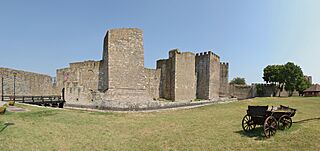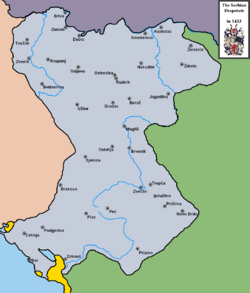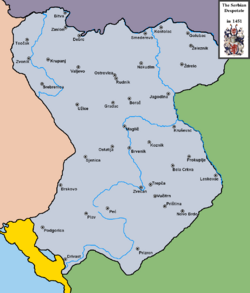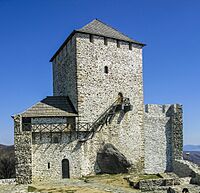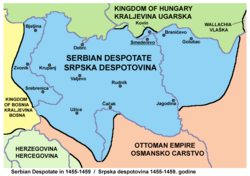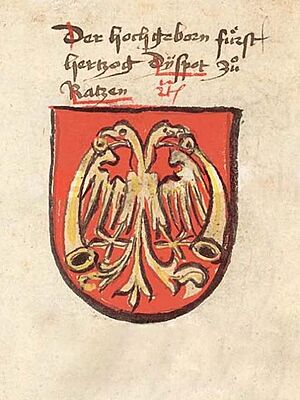Serbian Despotate facts for kids
Quick facts for kids
Serbian Despotate
Српска Деспотовина
Srpska Despotovina |
|||||||||||||||||
|---|---|---|---|---|---|---|---|---|---|---|---|---|---|---|---|---|---|
|
|||||||||||||||||

The Serbian Despotate in 1422
|
|||||||||||||||||
| Capital | |||||||||||||||||
| Common languages | Old Serbian | ||||||||||||||||
| Religion | Serbian Orthodox | ||||||||||||||||
| Demonym(s) | Serbian, Serb | ||||||||||||||||
| Government | Monarchy | ||||||||||||||||
| Despot | |||||||||||||||||
|
• 1402–1427
|
Stefan Lazarević | ||||||||||||||||
|
• 1427–1456
|
Đurađ Branković | ||||||||||||||||
|
• 1456–1458
|
Lazar Branković | ||||||||||||||||
| Establishment | |||||||||||||||||
| Historical era | Middle Ages | ||||||||||||||||
|
• Establishment
|
22 February 1402 | ||||||||||||||||
|
• Conquest by the Ottoman Empire
|
1439 | ||||||||||||||||
|
• Reestablishment
|
1444 | ||||||||||||||||
|
• Reconquest by the Ottoman Empire
|
20 June 1459 | ||||||||||||||||
| Currency | Serbian dinar | ||||||||||||||||
| ISO 3166 code | RS | ||||||||||||||||
|
|||||||||||||||||
| Today part of | |||||||||||||||||
The Serbian Despotate (Serbian: Српска деспотовина / Srpska despotovina) was a medieval Serbian state. It existed in the first half of the 15th century. Many people think medieval Serbia ended with the Battle of Kosovo in 1389. However, the Despotate, which followed the Serbian Empire, lasted another sixty years. It even had a time of great cultural, economic, and political growth. This was especially true when Stefan Lazarević was the Despot. After Despot Đurađ Branković died in 1456, the Despotate continued for three more years. It finally fell under Ottoman rule in 1459.
Even after 1459, the idea of the Serbian Despotate lived on. It continued in the medieval Kingdom of Hungary with several rulers called "titular despots." These rulers were chosen by the kings of Hungary. The very last titular Despot of Serbia was Pavle Bakić. He died in the Battle of Gorjani in 1537.
Contents
- History of the Despotate
- How the State Was Run
- How Land Was Organized
- Rulers of the Serbian Despotate
- See also
History of the Despotate
How the Despotate Began
After Prince Lazar Hrebeljanović died in the Battle of Kosovo on June 28, 1389, his young son Stefan Lazarević became the new ruler. Stefan's mother, Princess Milica, ruled for him until he was old enough. She was a smart and skilled woman. She helped calm the Ottoman threat by having her daughter Olivera marry Sultan Bayezid I.
Around 1390 or 1391, Serbia became a state that had to pay tribute to the Ottoman Empire. Stefan Lazarević had to help the Ottomans in battles. He did this in the 1395 Battle of Rovine against Prince Mircea I of Wallachia. He also helped in the 1396 Battle of Nicopolis against the Hungarian king Sigismund. Sultan Bayezid gave Stefan most of Vuk Branković's lands. This was because Branković had sided with the Hungarian king at Nicopolis.
In 1402, Timur's army entered the Ottoman lands. Stefan Lazarević fought in the Battle of Ankara. The Ottomans lost, and their leader Bayezid was captured. On his way back to Serbia, Stefan visited Constantinople. There, the Byzantine emperor Manuel II Palaiologos gave him the title of despot. In earlier times, this title meant ruling a state that served another. But the Byzantine Empire was too weak to demand this. So, Stefan Lazarević used the title as a ruler of his own state.
Stefan Lazarević: A Strong Leader
Building a Stronger Serbia
While in Constantinople, Stefan had a disagreement with his brother Vuk Lazarević. As they returned to Serbia, Stefan's army attacked Vuk near the Gračanica monastery. Stefan's army won. Vuk then joined forces with the new Ottoman sultan Suleyman (I) Çelebi.
In 1404, Stefan was worried about problems in the Ottoman Empire. He made an alliance with the Hungarian king Sigismund. The king gave him Belgrade, the Mačva region, and the fort of Golubac. Stefan made Belgrade his new capital city. He also made peace with his brother Vuk, who remained an Ottoman ally.
In 1405, Stefan married Caterina Gattilusio. She was the daughter of Francesco II Gattilusio, who ruled the island of Lesbos. His mother Milica also died that year.
In 1408, the two brothers argued again. Vuk, with Ottoman soldiers, attacked Belgrade in early 1409. Stefan was surrounded. He agreed to give the southern part of Serbia to Vuk and to become an Ottoman ally. However, Suleyman's brother Musa soon rebelled against Suleyman. Stefan sided with Musa in the 1410 battle of Kosmidion. Musa's army lost. Suleyman then sent Vuk to take Stefan's lands. But Vuk was captured and killed by one of Musa's allies. Through Emperor Manuel II, Stefan kept his title and returned to Belgrade. He also took over Vuk's lands.
In 1411, King Sigismund of Hungary rewarded Stefan's loyalty. He gave him Srebrenica and the areas around it.
Image:1422 Zeta in the Serbian Despotate after death Balsa III.svg
Musa's forces attacked Serbia in early 1412 but were defeated in Kosovo. Stefan then invited Sultan Mehmed Çelebi to attack Musa together. With Hungarian troops, they defeated Musa on July 5, 1413, at the Battle of Çamurlu. This battle was near the Vitosha mountain in modern Bulgaria. Musa was killed. Stefan gained the town of Koprijan near Niš and the Serbian-Bulgarian area of Znepolje. For the next twelve years, Stefan stayed on good terms with Mehmed. This allowed medieval Serbia to recover and grow stronger.
On April 28, 1421, Stefan's nephew, Balša III, died without children. Balša ruled Zeta. He left his lands to his uncle. With this and lands gained from Hungary, Serbia got back most of its traditional territories.
In 1425, the Ottoman Empire invaded Serbia. They burned and robbed across the Southern Morava valley. At the same time, the King of Bosnia tried to take Srebrenica back from the Serbs, but he failed. Stefan fought back the invasion. He then started talks with the Sultan. After this, the Ottoman troops left Serbia. However, this attack was a warning of harder times to come.
Art and Culture Flourish
Stefan Lazarević was a poet, thinker, and artist. His rule was a time when art grew again in Serbia. Stefan wrote one of the most important medieval Serbian books, Slovo ljubve ('The word of love'). He also built one of the biggest libraries in the Balkans at that time.
A Strong Economy
Serbia had political peace because Stefan was able to keep a good distance from both the Ottoman Empire and Hungary. Its economy also got a boost from very rich silver mines. These mines, in Srebrenica and Novo Brdo, were among the wealthiest in Europe. Belgrade became one of Europe's largest cities, with over 100,000 people. A writer named Constantine of Kostenets wrote about Despot Stefan Lazarević's rule and actions. He wrote "Life of Despot Stefan Lazarević" around 1430.
Đurađ Branković: A New Despot
First Time as Ruler
Despot Stefan had no children. So, he left his state to his nephew, Đurađ Branković. Đurađ became the new ruler after Stefan's death on July 19, 1427. The Byzantine emperor John VIII Palaeologus confirmed Đurađ as despot in 1429.
Right after Stefan's death, Serbia had to give Belgrade back to Hungary. This left Serbia without a capital city. The rich southern cities were also too close to the Ottoman border. So, Đurađ built a new capital city. It was the amazing fortress of Smederevo on the Danube River, near the Hungarian border. Smederevo was built between 1428 and 1430. This fortress led to many wrong ideas about history later on. Especially about Đurađ's wife, Jerina. Because Jerina was Greek and her brothers had influence with the new despot, people started to dislike her. They blamed her for many bad things, even saying she built Smederevo for silly reasons. In folk poems, she was called Prokleta Jerina (the Damned Jerina).
Right after becoming ruler in the summer of 1427, Đurađ faced an Ottoman invasion. The Ottomans took over Kruševac and Niš. They also took the Dubočica region, including Leskovac, and most of the Toplica region. They left after trying to capture Novo Brdo for several months without success.
King Tvrtko II of Bosnia had a fight with the Bosnian noble family of Zlatonosovići in November 1430. This was because Vukašin Zlatonosović supposedly worked with the Serbian Despotate. This fight ended with Vukašin's death and the Zlatonosović family being completely destroyed. But it led to another fight with Serbia itself. In the spring of 1433, Despot Đurađ took over parts of Usora. He also took the trading post Zvonik (Zvornik) and the fortress Teočak.
Đurađ married his daughter Katarina to Ulrich II of Celje in 1433. Ulrich was a close cousin of the Hungarian Queen. This was an effort to make relations better with Serbia's northern neighbor. Đurađ was forced to give his other daughter Mara to Sultan Murad II. The marriage was planned in 1433. But Đurađ delayed it until 1435 when the Ottomans threatened to invade. After the marriage, Sultan Murad promised to keep the peace between the Ottoman Empire and Serbia.
However, this promise was broken two years later. The Ottoman Empire invaded and started robbing inside Serbia in 1437. Đurađ had to agree to a bad peace deal with the Sultan. He gave him the town of Braničevo. In 1438, the Sultan attacked again. This time, the despot had to let them take Ždrelo and Višesav. The peace that followed did not last long either.
Ottoman Control for a Time
In 1439, the Ottoman army, led by Sultan Murad II himself, attacked and robbed Serbia again. Despot Đurađ escaped to Hungary in May 1439. He left his son Grgur Branković and Jerina's brother Thomas Kantakouzenos to defend Smederevo. After three months of being surrounded, Smederevo fell on August 18, 1439. Meanwhile, Novo Brdo fought back for two whole years. It fell on June 27, 1441. At that point, the only free part of the Despotate left was Zeta. However, Zeta was soon attacked by the Venetians and by Voivode Stefan Vukčić Kosača. The last of Đurađ's cities in that area were taken in March 1442.
The first Ottoman governor of Serbia was Ishak-Beg. He was replaced by Isa-Beg Isaković in 1443.
Đurađ Branković Returns
In Hungary, Đurađ Branković convinced Hungarian leaders to drive out the Ottomans. So, a large Christian army was formed. It included Hungarians (led by John Hunyadi), Serbs (led by Despot Đurađ), and Romanians (led by Vlad II Dracul). They moved into Serbia and Bulgaria in September 1443. This large Christian army crossed the Danube in early autumn of 1443. It had about 25,000 soldiers from Hungary and Poland. It also had over 8,000 Serbian cavalry and foot soldiers, and 700 Bosnian horsemen. Serbia was fully restored by the Peace of Szeged on August 15, 1444. Its borders were the same as before 1437. The only exceptions were the southern part of Zeta, which stayed with Venice, and fort Golubac. Golubac was returned to Serbia, even though it was lost much earlier, in 1427.
King Tomaš of Bosnia started another war with Despot Đurađ in 1446. He managed to take Srebrenica. However, in September 1448, the Bosnians were defeated by a Serbian army. This army was led by Thomas Kantakouzenos. He took back Srebrenica and also captured Višegrad.
Despot Đurađ had a hard time keeping a balance between two strong powers. For example, in 1447–48, he gave money to the Byzantines to fix the city walls of Constantinople. But because he was officially an Ottoman ally, he had to send a thousand soldiers to help Sultan Mehmed II conquer Constantinople in May 1453.
The new Ottoman Sultan, Mehmed II, who would later be called the Conqueror, gave the regions of Toplica and Dubočica back to Serbia in 1451. This was a sign of good will. At that time, Mehmed II and Đurađ talked about making their peace treaty last longer.
Without officially ending the peace treaty, Sultan Mehmed II invaded Serbia in mid-July 1454. Much of central Serbia fell. But the capital was well-prepared. The Ottomans heard that Hunyadi would cross the Danube to help the Serbs. So, they soon stopped trying to capture Smederevo. The Sultan went back to Sofia with stolen goods and slaves. He left most of his army at Kruševac. A smaller Serbian army led by Voivode Nikola Skobaljić, which was in Dubočica, was cut off from the north. They defeated an Ottoman army near Leskovac on September 24. The main army, led by Đurađ Branković and Hungarian forces led by Hunyadi, crushed the Ottomans at Kruševac. They captured their commander, Firuz-bey.
But these wins only gave them a little more time. Nikola Skobaljić's resistance was respected by the Turks because his army was small. But it was crushed by another Ottoman force on November 16, and he was killed. In early spring of 1455, the Sultan continued his invasion of Serbia. This time, the Ottomans focused on taking southern Serbia first. Novo Brdo was surrounded with powerful cannons. It fell on June 1, 1455, after forty days of fighting. The rest of southern Serbia was taken soon after. At the same time, Despot Đurađ tried to convince the Hungarians to start another holy war, but he returned to Smederevo without success. In early 1456, he agreed to a peace treaty with the Sultan. Southern Serbia remained in Ottoman hands.
A few months after the peace treaty, the Ottoman Empire attacked again. Both Smederevo and Belgrade were the main targets. They successfully fought back, but the countryside was destroyed even more. Despot Đurađ Branković died on December 24, 1456.
Lazar Branković: A Short Rule
Despot Lazar Branković was the only one of Đurađ's sons who was not blinded by the Ottomans. He became ruler after his father. He felt that Serbia was too weak to fight off a future Ottoman attack. So, he made a deal with Sultan Mehmed II on January 15, 1457. In this deal, he got back most of his father's lands. The Ottomans also promised not to bother Serbia until Lazar died. In return, Lazar had to pay a tribute. This payment was less because he no longer had the rich mines of Novo Brdo. For a while, the threat from the south was gone. Lazar then looked north to Hungarian internal fights. He joined King Ladislaus's side. He managed to capture the town of Kovin and several other towns on the left bank of the Danube in 1457.
Right after their mother Jerina died on May 3, 1457, the younger Branković family members started fighting over who would rule. Blind Grgur Branković wanted rights for his son Vuk. He fled to the Ottoman Empire with Mara and Thomas Kantakouzenos. Lazar's brother, blind Stefan Branković, stayed with him and supported him. Despot Lazar died suddenly on January 20, 1458.
Regency and Stefan Branković's Rule
Despot Lazar Branković had no sons. So, after his death, a group of three people was formed to rule. This group included Lazar's brother, the blind Stefan Branković. It also included Lazar's widow Helena Palaiologina and Grand Duke Mihailo Anđelović. Mihailo Anđelović's brother was the Ottoman Grand Vizier Mahmud-pasha Anđelović. Mihailo started to secretly plan with the Ottomans against Stefan and Helena. In March, he brought a small group of Ottoman soldiers into Smederevo. He wanted them to help him become the Despot. But the soldiers unexpectedly raised the Ottoman flag on the walls. They started shouting the Sultan's name. The angry people of Smederevo rose up against Anđelović on March 31. They took him prisoner and captured or killed most of the Ottoman soldiers. Stefan Branković was declared the new Despot. He, along with Helena Palaiologina, took control of Smederevo and the Despotate.
During the confusion after Lazar's death and the split in the ruling group, King Stjepan Tomaš of Bosnia attacked the Despotate's lands west of the Drina river. He took most of them, leaving only Teočak in the Despotate's hands. Mihail Silagyi also took most of Lazar's towns north of the Danube. Right after Mihailo Anđelović's failed plan, the Ottomans began another invasion of Serbia. They did not gain much land until 1459. But this was the start of the end for the Serbian Despotate. Stefan Branković ruled until April 8, 1459. He was then overthrown by a plan between Helena Palaiologina and King Tomaš. King Tomaš's son briefly ruled as the new Despot.
Stjepan Tomašević and the Fall of the Despotate
Stjepan Tomašević lost two countries to the Ottomans: Serbia in 1459 and Bosnia in 1463. His becoming the new despot was very unpopular. But his father, King Stjepan Tomaš of Bosnia, pushed hard for it. By this time, Serbia was only a narrow strip of land along the Danube. Sultan Mehmed II decided to conquer Serbia completely. He arrived at Smederevo. The new ruler did not even try to defend the city. After talks, the Bosnians were allowed to leave the city. Serbia was officially conquered by the Turks on June 20, 1459.
The Despotate in Exile
In 1404, Hungarian King Sigismund allowed Serbian Despot Stefan Lazarević to govern parts of Syrmia, Banat, and Bačka. Later, Đurađ Branković took over. After the Ottoman Empire conquered the Serbian Despotate in 1459, the Hungarian rulers continued the title of Despot for the House of Branković in exile. Later, it went to the noble family of Berislavići Grabarski. These despots continued to govern most of Syrmia until the Ottoman conquest. However, the area was still officially under the rule of the medieval Kingdom of Hungary. The despots lived in Kupinik (modern Kupinovo). The Despots from the Branković family were: Vuk Grgurević-Branković (1471–1485), Đorđe Branković (1486–1496), and Jovan Branković (1496–1502).
The last rulers with the title of despot were: Ivaniš Berislavić (1504–1514), Stjepan Berislavić (1520–1535), Radič Božić (1527–1528), and Pavle Bakić (1537).
How the State Was Run
The Serbian Despotate had several important noble positions. These officials had key duties in running the state. They worked under the Despot, who was the main ruler and highest authority.
- Grand Logothete (Велики Логотет/Veliki Logotet): This title was first used by the Byzantine Empire. The old Kingdom of Serbia adopted it, and the Despotate kept it. The Grand Logothete was in charge of the Despot's office. They made sure the central government worked well. The Grand Logothete was also the only person, besides the Despot and the Serbian Patriarch, who had some power over church matters.
- Stefan Ratković (1457–59)
- Grand Voivode (Велики Војвода/Veliki Vojvoda): This was the second-highest military leader in the state. They were under the Despot himself. But they had more power and respect than regular Voivodes.
- Mihailo Anđelović (1456–58)
- Grand Čelnik (Велики Челник/Veliki Čelnik): This title had many different duties in law and other civilian areas. They carried out the ruler's orders. They also represented the ruler in things like settling land disagreements between estates. The title of Grand Čelnik was similar to the Western European title of Comes Palatinus.
- Radič (active 1428–1433)
- Mihailo Anđelović (around 1445)
- Protovestiar (Протовестијар/Protovestijar): This was another Byzantine court title (protovestiarios) adopted by the old Kingdom of Serbia. The Protovestiar was in charge of the state's money. This included checking income and expenses and managing financial rules. After Serbia's first fall and freedom in 1444, the Protovestiar title disappeared. Its role was taken over by the Treasurer (Serbian: Ризничар/Rizničar). This title was earlier linked to managing the ruler's personal money.
- Paskoje Sorkočević (after 1444)
How Land Was Organized
In 1410, Despot Stefan Lazarević made changes to how the state was run. He divided the Despotate's land into districts. A district was called a Vlast (Serbian Cyrillic: Власт). Each Vlast was governed by a Voivode in the Despot's name. This change was needed because of the growing threat of Turkish invasion. It gave these Voivodes power over both civilian and military matters in their districts. The Vlasts stayed in place until the Despotate fell.
We have records about the Vlasts in Smederevo, Novo Brdo, Nekudim, Ostrovica, Golubac, Borač, Petrus, Lepenica, Kruševac, and Ždrelo. West of the Drina river, there were four Vlasts: Teočak, Tišnica, Zvonik, and Srebrenica. After it became part of the Serbian Despotate in 1421, Zeta was set up as one large Vlast. Its Voivode was based in Bar. Later, this moved to Podgorica (1444) and finally Medun.
We know almost nothing about the number and size of other Vlasts within the Despotate.
Rulers of the Serbian Despotate
| Name | Reign | Notes | |
|---|---|---|---|
|
Stefan Lazarević (1374–1427) |
August, 1402 – July 19, 1427 | Lazarević dynasty | |
|
Đurađ Branković (1375–1456) |
July 19, 1427 – August 18, 1439 | Branković dynasty | |
|
Grgur Branković (1416–59) |
May, 1439 – August 18, 1439 | co-regent for Đurađ | |
| Toma Kantakuzin | May, 1439 – August 18, 1439 | co-regent for Đurađ | |
| Ishak-Beg (d. 1443) | 1439–1443 | Ottoman governor | |
| Isa-Beg | 1443 – June 12, 1444 | Ottoman governor | |
| Đurađ Branković (1375–1456) |
June 12, 1444 – December 24, 1456 | restored | |
|
Lazar Branković (1421–58) |
December 24, 1456 – January 19, 1458 | Branković dynasty | |
|
Stefan Branković (1420–76) |
January 19, 1458 – March 21, 1459 | co-regent to March 1458 | |
| Mihailo Anđelović (d. 1464) | January 19, 1458 – March, 1458 | co-regent | |
| Jelena Paleolog (1432–73) | January 19, 1458 – March, 1458 | co-regent | |
| Stjepan Tomašević (1438–63) | March 21, 1459 – June 20, 1459 | Kotromanić dynasty | |
| Titular rulers of the Serbian Despotate in exile | |||
|
Vuk Grgurević Branković (1438–85) |
1471 – April 16, 1485 | Branković dynasty | |
|
Đorđe Branković (1461–1516) |
February, 1486 – July, 1497 | Branković dynasty | |
|
Jovan Branković (1462–1502) |
1492 – December 10, 1502 | Branković dynasty | |
| Ivaniš Berislavić (d. 1514) |
1504 – January, 1514 | Berislavići Grabarski | |
| Stefan Berislavić (1504–35) |
1520–1535 | Berislavići Grabarski | |
| Radič Božić (d. 1528) |
June 29, 1527 – September, 1528 | ||
| Pavle Bakić (d. 1537) |
September 20, 1537 – October 9, 1537 | Bakić noble family | |
See also
- History of Serbia
- Serbia in the Middle Ages
- Serbian Empire
- Smederevo Fortress
- Tsar Dušan





